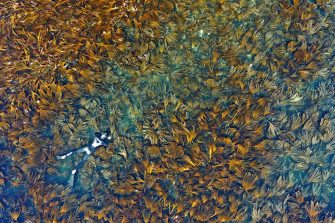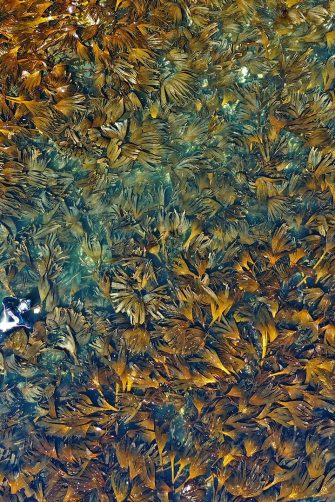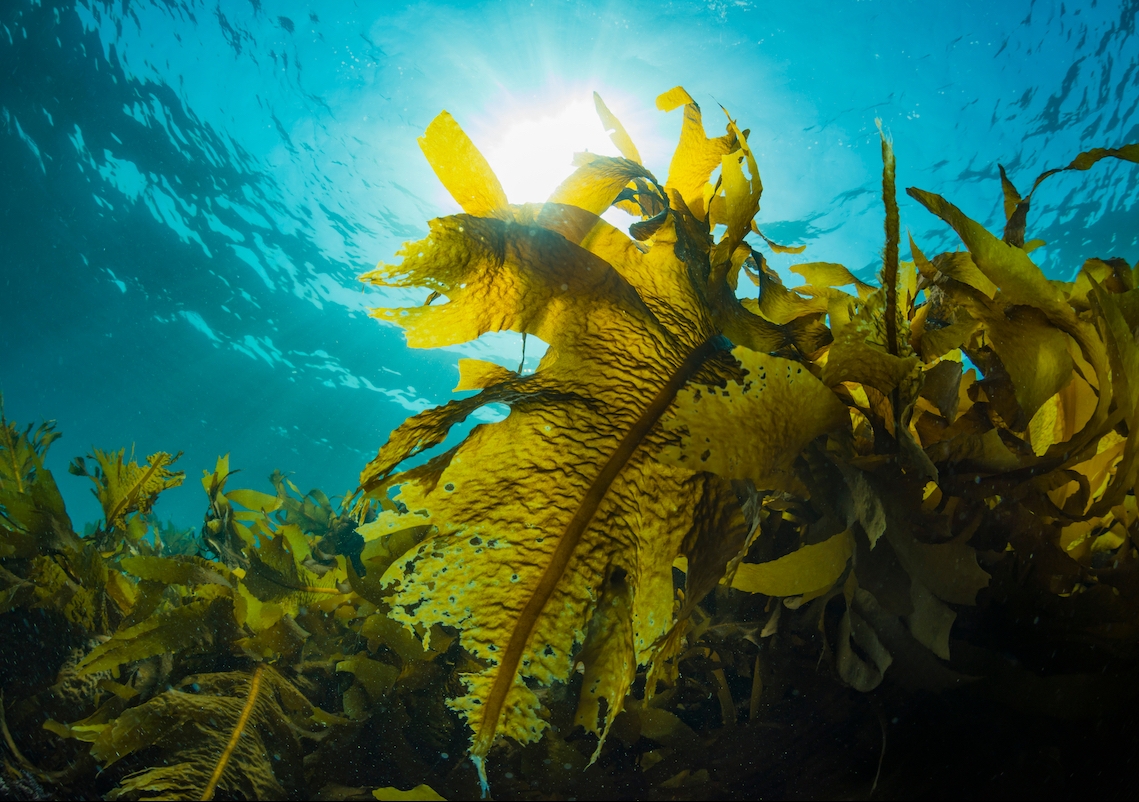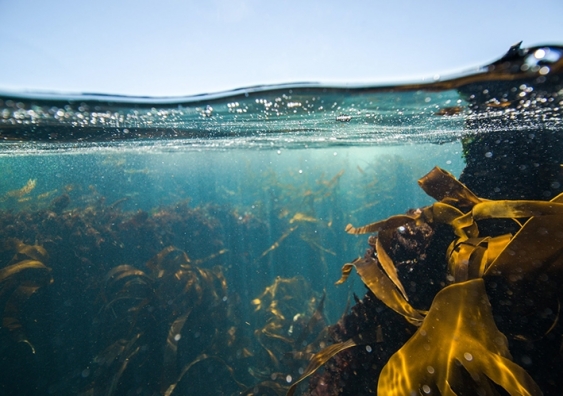The latest report shows slow progress on kelp restoration targets, but highlights the rapid growth of the international kelp forest community.
Most countries are making slow progress to protect and restore our vital underwater kelp forests, despite the fact they exist right off the coast of Australia, USA, the UK, and elsewhere, scientists at UNSW Sydney say.
The 'State of the World’s Kelp' report, launched at COP16 for the Convention on Biological Diversity, highlights the need to accelerate conservation of kelp forests, which over a third of the world's coastlines but receive minimal attention and funding compared with coral reefs and other marine ecosystems.
The report comes off the back of the Kelp Forest Challenge, an initiative launched in February 2023 by UNSW Science marine ecologist Dr Aaron Eger, which sets out to protect and restore 40% of kelp forests by 2040.
The 'State of the World’s Kelp' report, which includes a summary published today in the journal One Earth, assesses the progress and shortfalls for meeting the Kelp Forest Challenge and other international conservation targets.
“We wanted to get the best available information into the hands of people who are making the decisions,” says Dr Eger, who is based at UNSW’s School of Biological, Earth & Environmental Sciences. “So we analysed the data to see where kelp is threatened, how much is protected, what's the quality of that protection, and how much area has been restored both globally, and then broken down by country.”
The results found that only 2% of the kelp forest challenge for kelp restoration has been met, with South Korea making up 75% of this target.
By pairing this data with information on the value of kelp forests to society, the research team hopes to give governments the information they need to push to meet their biodiversity targets and protect and restore kelp forests.
Media enquiries
For enquiries about this story please contact Lilly Matson.
Tel: 0426 656 007
Email: l.matson@unsw.edu.au
Unique underwater forests
Kelp forests, which are made up of brown algae or seaweed, are one of the most unique and productive ecosystems on earth. Forests stretch across much of the world’s coastlines, supporting countless species and contributing billions of dollars to the global economy. “Kelp forests cover about a third of our world's coastlines. They're right next door to cities like New York, Los Angeles, Sydney, Tokyo, Cape Town and Santiago,” says Dr Eger.
They also play a crucial role in absorbing carbon dioxide, cycling nutrients, and supporting fisheries. The economic value of these ecosystem services is huge, estimated at over $500 billion a year. These underwater jungles also have the potential to help combat climate change by capturing carbon from the atmosphere and storing it in the deep ocean.
But kelp forests are under threat from climate change, pollution and overfishing. Although there is regional variation in the health of kelp forests, overall they are declining at an average rate of 1.8% per year. While it is essential to restore what we have lost, it is also a priority to protect existing forests.
“Kelp forest ecosystems benefit from healthy oceans and climate action and local and global communities must work together to save our kelps. This strategy means that we must combine different forms of protection or sustainable management, sustainable kelp harvest, fishing, pollution, or habitat destruction – all while addressing the climate crisis,” says Dr Eger.
“Kelp forests really are the fabric of the oceans along the coastal temperate regions of the world. And at the same time, they're often the forgotten forests. We need to connect the public, governments and, environmental agencies to the essential essence of these marine ecosystems.”
We created the Kelp Forest Challenge to fill in this gap, to draw attention to kelp forests and to get countries to realise their over commitments to the Global Biodiversity Framework while making sure that kelp wasn't left behind.
Setting targets
Several high-profile environmental targets have been set by various initiatives, such as The Bonn Challenge, to restore deforested landscapes. In fact, almost every country has committed to the ‘30x30 target’ set out by The Global Biodiversity Framework – a global initiative to protect and restore 30% of our planet's ecosystems by 2030.
And while progress is being made in many areas, kelp forests remain largely overlooked. In 2020, for every time a kelp forest was cited in international policy, mangroves were cited 43 times, coral reefs 38 times, salt marshes 20 times, and seagrass eight times.
“We created the Kelp Forest Challenge to fill in this gap, to draw attention to kelp forests and to get countries to realise their over commitments to the Global Biodiversity Framework while making sure that kelp wasn't left behind,” says Dr Eger.
With the right action, there’s a good chance that we could achieve the 30x30 target for protection of kelp forest by 2030, Dr Eger says, but there is very little chance of reaching the restoration target by the same time.
“Kelp restoration is really just getting started, so we created the 2040 date in recognition that we maybe have further to go because kelp has been neglected so consistently, and we wanted to achieve something that feels possible,” he adds.
Dr Eger, alongside Professor Adriana Verges, produced the 'State of the World's Kelp' report as a world-first assessment of the current conservation status of global kelp forests.
Areas restored and areas protected
The conservation efforts in the report are broken down into areas restored and areas protected.
The Kelp Forest Challenge maintains an open, collaborative database that allows projects to track their restoration progress towards the targets. “This database provides a straightforward way to tabulate those values in a standardised fashion – hectares restored – so that data is entered comparably across different projects, different countries and different languages,” says Dr Eger. “It also keeps the information open to the public so people can follow along and see the journey to restore kelp in their home country.”
Next, the team had to assess the area of kelp forests protected globally, something that has never been calculated before, partly due to how difficult it is to map kelp forests underwater.
“We don’t actually have complete maps of where kelp is worldwide, instead we got hold of the best possible information on kelp habitat and where in the world it could potentially occur,” says Dr Eger. “We then overlaid that with the latest data on protected areas around the world, which ranged from really tightly protected to loosely protected.”
Geospatial differences
The results were mapped and analysed geospatially, country by country.
After analysing the database, the team found that globally, only 2% of the Kelp Forest Challenge restoration target had been met. “And that figure is even smaller when you consider that South Korea is responsible for about 75% of that value,” says Dr Eger.
“Outside of Japan and South Korea, very little has been done today to restore kelp at large scales. Korea is restoring about 4000-5000 hectares a year, Japan is second, and Australia is about fourth or fifth in that list.”
So, what can other countries learn from kelp restoration in South Korea?
A large amount of the restoration in South Korea happens through work with aquaculture or seaweed farmers, Dr Eger explains. “In Australia, we'll often collect the kelp from the wild and maybe go in a lab somewhere to grow it and then transplant it back into the ocean,” he says. “Korea has a far more industrialised process, and so they're able to produce that source material to much larger scale for a much lower cost. And then with that, they've also created this entire restoration economy, so it's not so sporadic, instead, it's professionals that are doing the restoration, supported by the government.”
The study also found that while approximately 16% of global kelp forests fell into a protected marine area, less than 2% of those habitat areas strictly managed fishing, and fishing of top predators was one of the main threats to kelp forests.
“Importantly, we're not just trying to restore the kelp plant itself, but everything that comes with it,” says Dr Eger. “So the protected areas are really about that kind of holistic protection for a kelp ecosystem. And there’s some benefit that comes from being a protected area, say, when it comes to pollution or human impact or development that's much more tightly managed in a protected area. Protection is therefore creating a healthier ocean ecosystem, overall.”
An opportunity to help
While the 'State of the World’s Kelp' report reveals how far we still have to go to reach international targets, the assessment also highlights how the kelp forest community is growing rapidly, with over 550 members signed up, from 300 countries.
“All of this information is living,” says Dr Eger. “It's updated, it's highly collaborative, and the values are improving as we move forward.”
The team wants to use this opportunity highlight the importance of kelp ecosystems, and how frequently they are left out of national conservation action plans.
“But this is also an opportunity to expand our perception of what is in the ocean, how we connect with the ocean, what we need to do for the ocean,” says Dr Eger. “Even today, some people still don't see the ocean as something that can be impacted because it's so vast. But without a doubt, we are having that impact, and conversely, we are being given the opportunity to do something positive instead.”







